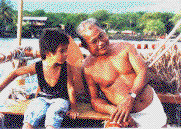 |
|
Voyaging into Polynesia's Past Ben Finney The crossing from Hawai'i to Tahiti presented two main challenges, one in sailing, the other in navigation. The longitude of the Hawaiian island of Maui, our starting point, lies some 500 miles west of the longitude of Tahiti. Since the trade winds along the route generally blow from the northeast above the equator, and from the southeast below it, in order to reach Tahiti, Hokule'a had to sail well enough to windward to make up the 500 miles of longitude and while also fighting the westward moving current that typically accompanies the trades. Our strategy to accomplish this was to sail as hard into the wind as the canoe would point without losing too much speed in order to gain maximum easting in the northeast trades, and then to hold on to as much of that easting as possible when, below the equator, the winds shift to the southeast and would start pushing us to the southwest. The navigational problem was also considerable: how to guide a canoe, without any instruments or other aids, over the open ocean from the Northern to the Southern Hemisphere and, after a month at sea, find the island of Tahiti. The voyage went as planned. Despite a week spent becalmed in the doldrums, and then an encounter just below the equator with headwinds that for a time threatened to drive the canoe to the west of Tahiti, in 30 days at sea, Hokule'a made enough easting against the trades to reach the atoll of Matahiva, the westernmost island of the Tuamotus from where it was easy to sail on to Tahiti. Even when days of solid cloud cover hid from sight the stars, sun and moon, Mau was able to keep the canoe on course and to keep in his mind a picture of the canoe's progress toward Tahiti. And, obligingly, small, white terns skimming over the sea provided Mau with a sign that Matahiva was near before we could actually see this low island. [The canoe left from Honolua Bay, Maui, on May 1, 1976; the crew sighted Matahiva on June 1, 1976. After a day and a half on Mata`iva, the canoe sailed on a reach to Tahiti, arriving on June 4, thirty-four days after departing from Maui.] With the canoe sailing freely across strong trade winds, the voyage back to Hawai'i was completed in only 22 days, although unfortunately we were forced to navigate Hokule'a home by modern means as right after arriving in Tahiti Mau had flown back to Micronesia. Nonetheless, the navigational feat of guiding the canoe to Tahiti without instruments, as well as the performance of the canoe over the entire round trip, effectively demonstrated how Polynesian canoes and traditional navigational methods were up to the task of planned, long-distance voyaging, effectively turning the tide against Sharp and his revival of the Lang accidental settlement hypothesis. [During this historic first voyage to Tahiti, some of the Hawaiian crew members came into conflict with haole crew members. The conflict stemmed from two very different views of the voyage: for the haole crew members, the voyage was a scientific experiment to learn the techniques by which Polynesians had explored and settled the Pacific; for some of the Hawaiians, the voyage was an highly emotional journey of cultural reawakening. The crew's family and work sacrifices and frustrations in preparing for Hokule`a's first long voyage, and the hardships and inequities during that voyage aggravated the differences. After landfall, both sides vented their frustration and anger,which eventually erupted in physical hostilities on board the canoe. For Finney's account of the blows on the canoe and the tensions that led up to it, see Hokule'a: The Way to Tahiti. Since the first voyage, the crew members have reconciled with each other, and crew members and volunteers of all ethnicities have contributed to and are working together to keep alive the voyaging traditions they cherish.] [This account of the 1976 voyage to Tahiti was originally published as part of "Voyaging into Polynesia's Past" in From Sea to Space (Palmerston North: Massey University, 1992. 5-65). Other parts of this article: Part 1--The Founding of the Polynesian Voyaging Society; Part 2--Hawai'i to Tahiti and Return: 1976; Part 3--Hawai'i to Tahiti and Return: 1980; Part 4--Voyage of Rediscovery: 1985-87. Click here for Finney's account of the 1995 Voyage to Ra'iatea and Nukuhiva, Sin at Awarua]. |
